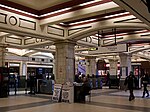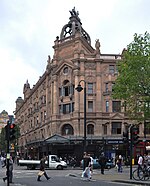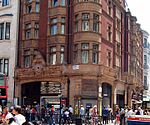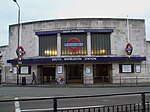
The London Underground is a metro system serving a large part of Greater London and parts of Buckinghamshire, Hertfordshire and Essex. Seventy-one of the 272 London Underground stations use buildings that are on the Statutory List of Buildings of Special Architectural or Historic Interest, and five have entrances in listed buildings. Buildings are given one of three grades: Grade I for buildings of exceptional interest, Grade II* for particularly important buildings of more than special interest and Grade II for buildings that are of special interest.
The Metropolitan Railway's original seven stations were inspired by Italianate designs, with platforms lit by daylight from above and by gas lights in large glass globes, and the early District Railway stations were similar; on both railways the further from central London the station the simpler the construction. The City & South London Railway's architect Thomas Phillips Figgis designed red-brick buildings topped with a lead-covered dome containing the lift mechanism, such as the Grade II listed station at Kennington. The Central London Railway appointed Harry Bell Measures as architect, who designed its pinkish-brown steel-framed buildings with larger entrances. In the first decade of the 20th century Leslie Green established a house style for the tube stations built by the UERL, which were clad in ox-blood faience blocks; eleven of these stations are listed. Harry W. Ford was responsible for the design of at least 17 UERL and District Railway stations, including the listed Barons Court. The Met's architect Charles W Clark had used a neo-classical design for rebuilding Baker Street and Paddington Praed Street stations before World War I and, although the fashion had changed, continued with Farringdon in 1923. In the 1920s and 1930s, Charles Holden designed a series of modernist and art-deco stations, some of which he described as his "brick boxes with concrete lids", many of which are listed, five at Grade II*. Holden's design for the Underground's headquarters building at 55 Broadway including avant-garde sculptures by Jacob Epstein, Eric Gill and Henry Moore, incorporates St James Park station and is listed Grade I.
Stations
See also
Map all coordinates using OpenStreetMapDownload coordinates as:
References
Notes
- "Heritage Library: Underground: Line". Urban Design. Transport for London. Archived from the original on 23 May 2013.
- "Protecting, conserving and providing access to the historic environment in England". Department for Digital, Culture, Media and Sport. 27 February 2013. Retrieved 7 May 2013.
- Ovenden 2013, pp. 11, 18–19.
- Ovenden 2013, pp. 26, 28.
- Ovenden 2013, p. 35.
- ^ Historic England. "Details from listed building database (1385635)". National Heritage List for England. Retrieved 3 April 2015.
- ^ Ovenden 2013, p. 38.
- Ovenden 2013, pp. 60–61, 70.
- "Heritage Library: Underground: Architect". Urban Design. Transport for London. Archived from the original on 16 August 2012.
- Ovenden 2013, pp. 41, 63.
- ^ Historic England. "Details from listed building database (1358562)". National Heritage List for England. Retrieved 3 April 2015.
- Ovenden 2013, pp. 150–152.
- Ovenden 2013, p. 146.
- "Underground Journeys: Charles Holden's designs for London Transport" (PDF). V&A RIBA architecture partnership. n.d. Archived from the original (PDF) on 14 March 2012. Retrieved 15 April 2013.
- Leboff 1994, p. 6.
- Historic England. "Details from listed building database (1263471)". National Heritage List for England. Retrieved 3 April 2015.
- "Acton Town". Urban Design. Transport for London. Archived from the original on 16 August 2012.
- "Aldgate East". Urban Design. Transport for London. Archived from the original on 16 August 2012.
- Historic England. "Details from listed building database (1065733)". National Heritage List for England. Retrieved 3 April 2015.
- Historic England. "Details from listed building database (1401034)". National Heritage List for England. Retrieved 3 April 2015.
- Leboff 1994, p. 12.
- Historic England. "Details from listed building database (1358981)". National Heritage List for England. Retrieved 3 April 2015.
- "Arnos Grove". Urban Design. Transport for London. Archived from the original on 16 August 2012.
- Historic England. "Details from listed building database (1239815)". National Heritage List for England. Retrieved 3 April 2015.
- "Baker Street". Urban Design. Transport for London. Archived from the original on 9 January 2013.
- "Bank". Urban Design. Transport for London. Archived from the original on 16 August 2012.
- Historic England. "Details from listed building database (1079134)". National Heritage List for England. Retrieved 3 April 2015.
- Historic England. "Church of St Mary Woolnoth (1064620)". National Heritage List for England. Retrieved 3 April 2015.
- Leboff 1994, p. 16.
- Historic England. "Details from listed building database (1225887)". National Heritage List for England. Retrieved 3 April 2015.
- "Balham". Urban Design. Transport for London. Archived from the original on 16 August 2012.
- Historic England. "Details from listed building database (1242678)". National Heritage List for England. Retrieved 3 April 2015.
- "Barking". Urban Design. Transport for London. Archived from the original on 16 August 2012.
- Leboff 1994, p. 18.
- Historic England. "Details from listed building database (1081012)". National Heritage List for England. Retrieved 3 April 2015.
- "Barkingside". Urban Design. Transport for London. Archived from the original on 16 August 2012.
- Leboff 1994, p. 20.
- "Barons Court". Urban Design. Transport for London. Archived from the original on 16 August 2012.
- ^ Leboff 1994, p. 21.
- Historic England. "Details from listed building database (1401089)". National Heritage List for England. Retrieved 3 April 2015.
- "Belsize Park". Urban Design. Transport for London. Archived from the original on 30 August 2012.
- Leboff 1994, p. 23.
- Historic England. "Details from listed building database (1063901)". National Heritage List for England. Retrieved 3 April 2015.
- "Boston Manor". Urban Design. Transport for London. Archived from the original on 16 August 2012.
- ^ Leboff 1994, p. 24.
- Historic England. "Details from listed building database (1393641)". National Heritage List for England. Retrieved 3 April 2015.
- "Bounds Green". Urban Design. Transport for London. Archived from the original on 16 August 2012.
- Historic England. "Details from listed building database (1357787)". National Heritage List for England. Retrieved 3 April 2015.
- "Bow Road". Urban Design. Transport for London. Archived from the original on 16 August 2012.
- Historic England. "Details from listed building database (1401123)". National Heritage List for England. Retrieved 3 April 2015.
- "Brent Cross". Urban Design. Transport for London. Archived from the original on 16 August 2012.
- Historic England. "Details from listed building database (1401086)". National Heritage List for England. Retrieved 3 April 2015.
- "Caledonian Road". Urban Design. Transport for London. Archived from the original on 16 August 2012.
- Historic England. "Details from listed building database (1401028)". National Heritage List for England. Retrieved 3 April 2015.
- "Chalk Farm". Urban Design. Transport for London. Archived from the original on 16 August 2012.
- Historic England. "Details from listed building database (1401704)". National Heritage List for England. Retrieved 3 April 2015.
- "Chesham". Urban Design. Transport for London. Archived from the original on 16 August 2012.
- Historic England. "Details from listed building database (1358798)". National Heritage List for England. Retrieved 3 April 2015.
- "Chiswick Park". Urban Design. Transport for London. Archived from the original on 16 August 2012.
- Leboff 1994, pp. 35–36.
- Historic England. "Details from listed building database (1065005)". National Heritage List for England. Retrieved 3 April 2015.
- "Clapham Common". Urban Design. Transport for London. Archived from the original on 16 August 2012.
- Leboff 1994, p. 36.
- Historic England. "Details from listed building database (1266140)". National Heritage List for England. Retrieved 3 April 2015.
- "Clapham South". Urban Design. Transport for London. Archived from the original on 16 August 2012.
- Leboff 1994, pp. 36–37.
- Historic England. "Details from listed building database (1358718)". National Heritage List for England. Retrieved 3 April 2015.
- "Cockfosters". Urban Design. Transport for London. Archived from the original on 25 May 2013.
- Leboff 1994, p. 38.
- Historic England. "Details from listed building database (1080925)". National Heritage List for England. Retrieved 3 April 2015.
- "Colliers Wood". Urban Design. Transport for London. Archived from the original on 16 August 2012.
- Historic England. "Details from listed building database (1401025)". National Heritage List for England. Retrieved 3 April 2015.
- "Covent Garden". Urban Design. Transport for London. Archived from the original on 16 August 2012.
- Historic England. "Details from listed building database (1249986)". National Heritage List for England. Retrieved 3 April 2015.
- "Ealing Common". Urban Design. Transport for London. Archived from the original on 7 May 2013.
- "Earl's Court". Urban Design. Transport for London. Archived from the original on 16 August 2012.
- Historic England. "Details from listed building database (1357435)". National Heritage List for England. Retrieved 3 April 2015.
- "Eastcote". Urban Design. Transport for London. Archived from the original on 16 August 2012.
- Leboff 1994, pp. 44–45.
- Historic England. "Details from listed building database (1359150)". National Heritage List for England. Retrieved 3 April 2015.
- "East Finchley". Urban Design. Transport for London. Archived from the original on 16 August 2012.
- Historic England. "Details from listed building database (1245066)". National Heritage List for England. Retrieved 3 April 2015.
- "East Ham". Urban Design. Transport for London. Archived from the original on 16 August 2012.
- Historic England. "Details from listed building database (1298047)". National Heritage List for England. Retrieved 3 April 2015.
- "Farringdon". Urban Design. Transport for London. Archived from the original on 16 August 2012.
- Historic England. "Details from listed building database (1358569)". National Heritage List for England. Retrieved 3 April 2015.
- "Fulham Broadway". Urban Design. Transport for London. Archived from the original on 16 August 2012.
- Historic England. "Details from listed building database (1080658)". National Heritage List for England. Retrieved 3 April 2015.
- "Gloucester Road". Urban Design. Transport for London. Archived from the original on 16 August 2012.
- Historic England. "Details from listed building database (1213650)". National Heritage List for England. Retrieved 3 April 2015.
- "Great Portland Street". Urban Design. Transport for London. Archived from the original on 16 August 2012.
- "Green Park". Urban Design. Transport for London. Archived from the original on 16 August 2012.
- Historic England. "Details from listed building database (1226746)". National Heritage List for England. Retrieved 3 April 2015.
- ^ "Harrow & Wealdstone". Urban Design. Transport for London. Archived from the original on 16 August 2012.
- Historic England. "Details from listed building database (1253986)". National Heritage List for England. Retrieved 3 April 2015.
- Historic England. "Details from listed building database (1253982)". National Heritage List for England. Retrieved 3 April 2015.
- Historic England. "Details from listed building database (1401082)". National Heritage List for England. Retrieved 3 April 2015.
- "Hendon Central". Urban Design. Transport for London. Archived from the original on 16 August 2012.
- Historic England. "Details from listed building database (1195635)". National Heritage List for England. Retrieved 3 April 2015.
- "Holloway Road". Urban Design. Transport for London. Archived from the original on 16 August 2012.
- Historic England. "Details from listed building database (1241237)". National Heritage List for England. Retrieved 3 April 2015.
- "Hounslow West". Urban Design. Transport for London. Archived from the original on 6 June 2013.
- "Kennington". Urban Design. Transport for London. Archived from the original on 16 August 2012.
- Historic England. "Details from listed building database (1031878)". National Heritage List for England. Retrieved 3 April 2015.
- "Kew Gardens". Urban Design. Transport for London. Archived from the original on 16 August 2012.
- Historic England. "Details from listed building database (1078871)". National Heritage List for England. Retrieved 3 April 2015.
- "Kilburn Park". Urban Design. Transport for London. Archived from the original on 16 August 2012.
- Historic England. "Details from listed building database (1066287)". National Heritage List for England. Retrieved 3 April 2015.
- "Leicester Square". Urban Design. Transport for London. Archived from the original on 9 August 2012.
- Historic England. "Details from listed building database (1141221)". National Heritage List for England. Retrieved 3 April 2015.
- "Loughton". Urban Design. Transport for London. Archived from the original on 16 August 2012.
- Historic England. "Details from listed building database (1066834)". National Heritage List for England. Retrieved 3 April 2015.
- "Maida Vale". Urban Design. Transport for London. Archived from the original on 5 November 2012.
- Historic England. "Details from listed building database (1359213)". National Heritage List for England. Retrieved 3 April 2015.
- "Moorgate". Urban Design. Transport for London. Archived from the original on 16 August 2012.
- "Moorgate (Nos. 94–100 Finsbury Circus)". Urban Design. Transport for London. Archived from the original on 16 August 2012.
- Historic England. "Details from listed building database (1064691)". National Heritage List for England. Retrieved 3 April 2015.
- Historic England. "Details from listed building database (1378713)". National Heritage List for England. Retrieved 3 April 2015.
- "Mornington Crescent". Urban Design. Transport for London. Archived from the original on 16 August 2012.
- Historic England. "Details from listed building database (1390751)". National Heritage List for England. Retrieved 3 April 2015.
- "North Ealing". Urban Design. Transport for London. Archived from the original on 16 August 2012.
- Historic England. "Details from listed building database (1263487)". National Heritage List for England. Retrieved 3 April 2015.
- "Northfields". Urban Design. Transport for London. Archived from the original on 16 August 2012.
- Historic England. "Details from listed building database (1225688)". National Heritage List for England. Retrieved 3 April 2015.
- "Notting Hill Gate". Urban Design. Transport for London. Archived from the original on 16 August 2012.
- Historic England. "Details from listed building database (1078930)". National Heritage List for England. Retrieved 3 April 2015.
- "Oakwood". Urban Design. Transport for London. Archived from the original on 16 August 2012.
- Historic England. "Details from listed building database (1240806)". National Heritage List for England. Retrieved 3 April 2015.
- "Osterley". Urban Design. Transport for London. Archived from the original on 24 May 2013.
- Historic England. "Details from listed building database (1400976)". National Heritage List for England. Retrieved 3 April 2015.
- ^ "Oxford Circus". Urban Design. Transport for London. Archived from the original on 16 August 2012.
- Historic England. "Details from listed building database (1401022)". National Heritage List for England. Retrieved 3 April 2015.
- Historic England. "Details from listed building database (1392020)". National Heritage List for England. Retrieved 3 April 2015.
- "Paddington". Urban Design. Transport for London. Archived from the original on 16 August 2012.
- Leboff 1994, p. 107.
- Historic England. "Details from listed building database (1079328)". National Heritage List for England. Retrieved 3 April 2015.
- "Park Royal". Urban Design. Transport for London. Archived from the original on 23 May 2013.
- Leboff 1994, pp. 108–9.
- Historic England. "Details from listed building database (1400747)". National Heritage List for England. Retrieved 3 April 2015.
- "Perivale". Urban Design. Transport for London. Archived from the original on 16 August 2012.
- ^ Leboff 1994, p. 109.
- Historic England. "Details from listed building database (1226877)". National Heritage List for England. Retrieved 3 April 2015.
- "Piccadilly Circus". Urban Design. Transport for London. Archived from the original on 16 August 2012.
- Historic England. "Details from listed building database (1261430)". National Heritage List for England. Retrieved 3 April 2015.
- "Rayner's Lane". Urban Design. Transport for London. Archived from the original on 16 August 2012.
- Leboff 1994, pp. 113–114.
- Historic England. "Details from listed building database (1401101)". National Heritage List for England. Retrieved 3 April 2015.
- "Redbridge". Urban Design. Transport for London. Archived from the original on 16 August 2012.
- Leboff 1994, pp. 116.
- Historic England. "Details from listed building database (1380983)". National Heritage List for England. Retrieved 3 April 2015.
- "Ruislip". Urban Design. Transport for London. Archived from the original on 16 August 2012.
- Leboff 1994, p. 118.
- Historic England. "Details from listed building database (1401730)". National Heritage List for England. Retrieved 3 April 2015.
- "Russell Square". Urban Design. Transport for London. Archived from the original on 16 August 2012.
- Leboff 1994, pp. 124–5.
- Historic England. "Details from listed building database (1392067)". National Heritage List for England. Retrieved 3 April 2015.
- "South Kensington". Urban Design. Transport for London. Archived from the original on 16 August 2012.
- Leboff 1994, pp. 126–7.
- Historic England. "Details from listed building database (1358037)". National Heritage List for England. Retrieved 3 April 2015.
- "South Wimbledon". Urban Design. Transport for London. Archived from the original on 16 August 2012.
- Leboff 1994, pp. 127–8.
- Historic England. "Details from listed building database (1188692)". National Heritage List for England. Retrieved 3 April 2015.
- "Southgate". Urban Design. Transport for London. Archived from the original on 12 January 2013.
- Leboff 1994, p. 128.
- Historic England. "Details from listed building database (1219790)". National Heritage List for England. Retrieved 3 April 2015.
- "St James's Park". Urban Design. Transport for London. Archived from the original on 16 August 2012.
- Leboff 1994, pp. 128–129.
- Historic England. "Details from listed building database (1401096)". National Heritage List for England. Retrieved 3 April 2015.
- "St John's Wood". Urban Design. Transport for London. Archived from the original on 16 August 2012.
- Leboff 1994, p. 132.
- Historic England. "Details from listed building database (1254171)". National Heritage List for England. Retrieved 3 April 2015.
- "Sudbury Hill". Urban Design. Transport for London. Archived from the original on 16 August 2012.
- Leboff 1994, pp. 132–133.
- Historic England. "Details from listed building database (1294594)". National Heritage List for England. Retrieved 3 April 2015.
- "Sudbury Town". Urban Design. Transport for London. Archived from the original on 16 August 2012.
- ^ Leboff 1994, p. 136.
- Historic England. "Details from listed building database (1065477)". National Heritage List for England. Retrieved 3 April 2015.
- "Tooting Bec". Urban Design. Transport for London. Archived from the original on 16 August 2012.
- Historic England. "Details from listed building database (1065478)". National Heritage List for England. Retrieved 3 April 2015.
- "Tooting Broadway". Urban Design. Transport for London. Archived from the original on 16 August 2012.
- Leboff 1994, p. 140.
- Historic England. "Details from listed building database (1263624)". National Heritage List for England. Retrieved 3 April 2015.
- "Turnpike Lane". Urban Design. Transport for London. Archived from the original on 16 August 2012.
- Historic England. "Details from listed building database (1358405)". National Heritage List for England. Retrieved 3 April 2015.
- "Uxbridge". Urban Design. Transport for London. Archived from the original on 16 August 2012.
- Historic England. "Details from listed building database (1393965)". National Heritage List for England. Retrieved 3 April 2015.
- "Watford". Urban Design. Transport for London. Archived from the original on 5 November 2012.
- Historic England. "Details from listed building database (1400997)". National Heritage List for England. Retrieved 3 April 2015.
- "West Acton". Urban Design. Transport for London. Archived from the original on 27 May 2013.
- Historic England. "Details from listed building database (1385365)". National Heritage List for England. Retrieved 3 April 2015.
- "West Brompton". Urban Design. Transport for London. Archived from the original on 16 August 2012.
- Historic England. "Details from listed building database (1391808)". National Heritage List for England. Retrieved 3 April 2015.
- "Willesden Green". Urban Design. Transport for London. Archived from the original on 16 August 2012.
- Historic England. "Details from listed building database (1401120)". National Heritage List for England. Retrieved 3 April 2015.
- "Wood Green". Urban Design. Transport for London. Archived from the original on 16 August 2012.
Books
- Leboff, David (1994). London Underground Stations. Ian Allan. ISBN 978-0-7110-2226-3.
- Ovenden, Mark (2013). London Underground by Design. Penguin Books. ISBN 978-1-84614-417-2.
External links
- Underground Journeys: Charles Holden's designs for London Transport (online exhibition from the Royal Institute of British Architects)














































































